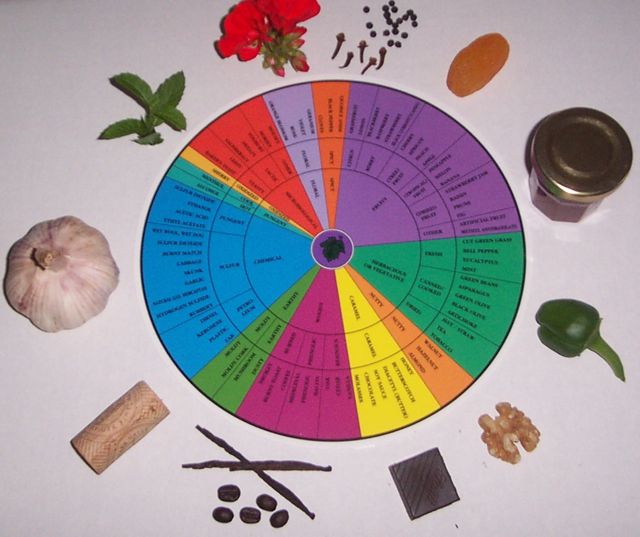What is the Wine Aroma Wheel?
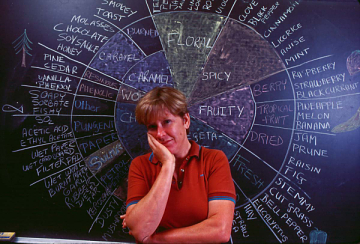
The wine aroma wheel was created in the 1980s by Dr. Ann C. Noble at the University of California at Davis. Professor Noble was teaching wine sensory evaluation in the world renowned Viticulture and Enology program as well as conducting research on varietal wine flavors. Very quickly she realized how difficult it was for untrained tasters to describe the aromas they were perceiving when they were comparing wines. Others would use flowery terms, however these were useless to analytical researchers. To characterize the unique flavors of Cabernet Sauvignon or Merlot, they needed precise descriptors that they could relate to grape growing, winemaking or genetics of the wines.
(Photo borrowed from The National Museum of American History website)
To achieve that goal, Ann conducted descriptive analysis of wine, which required tasters to analyse their perceptions, decompose them, label them with specific words called descriptors and then measure the intensity of these perceptions on a scale to indicate the strength of the perceptions.
This sensory task is rather difficult if you have not practiced before. A novice taster would freeze in the “Tip of the Nose” state: the aromas are familiar to them, however the right words get stuck on their tongue or rather, their nose!
Working with the Sensory Evaluation Sub-Committee of the American Society for Enology and Viticulture, Ann looked at developing a tool to help wine tasters label their wine perceptions with precise terms.
Watch this interview of Ann about her invention.
So what is the Wine Aroma Wheel?
It is a tool that helps you categorize the aromas you perceived when smelling or when tasting the wine.
Why would you need to categorize wine aromas?
Not to impress your entourage, no!
Categorizing wine aroma helps you remember the wines you have tasted and also helps you to share with others what you experiencing.
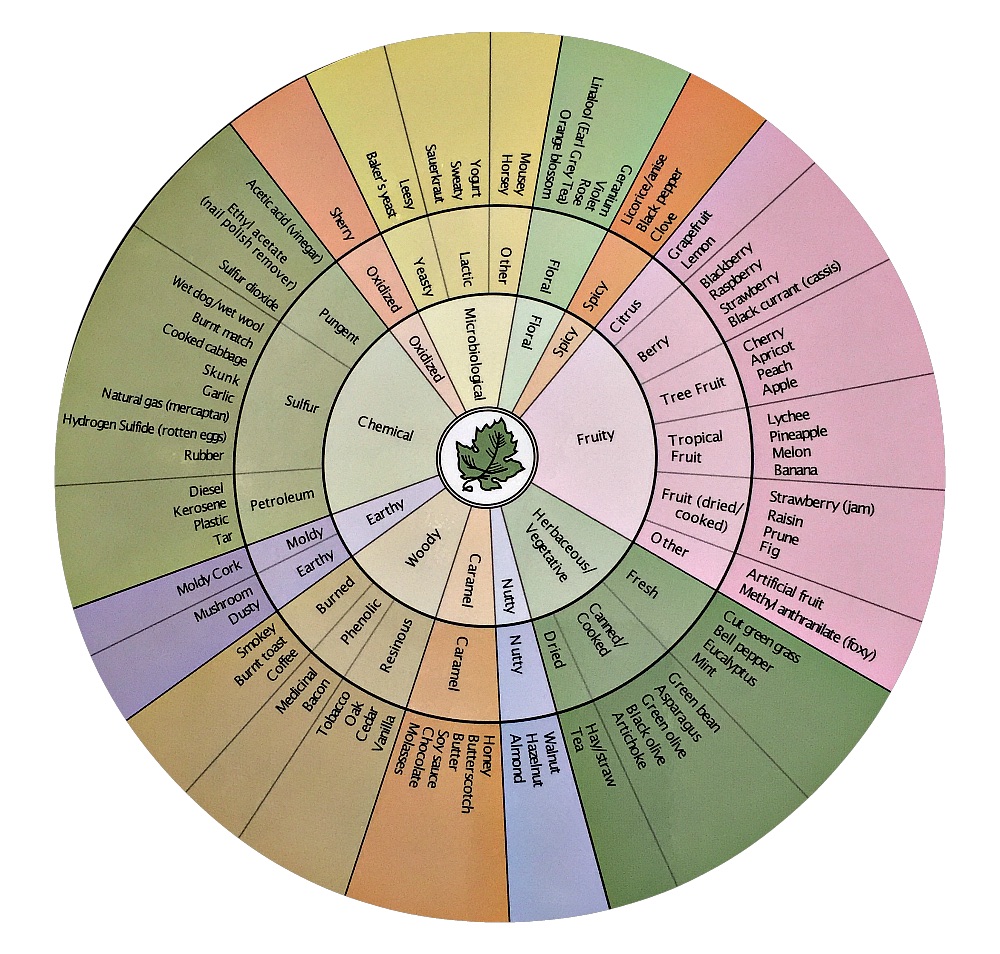
Think of how you would describe a painting to someone who is blindfolded.
You may describe the size and shape of the canvas, the colors, the objects or people represented in the painting, etc. Your description can be very general or very detailed.
Well, you can do the same when you smell or taste wine. You can describe with generic terms such as fruity, floral, or spicy.
And start analyzing what you perceive: Are they more fruity cooked or fruity fresh, from berries or stone fruits?
With such a process, you start decomposing your perceptions, you start being more specific and therefore more able to articulate your tasting experience to others.
While it could have been easy just to impose a classification, Ann and her colleagues went on to compare many wines and aroma compounds to determine how aromas were perceived similarly or differently. This was how the aroma groups were determined and after several years of research, the wine aroma wheel was published in 1984 and revised in 1987.
Noble, A. C., Arnold, R. A., Masuda, B. M., Pecore, S. D., Schmidt, J. O., & Stern, P. M. (1984). Progress towards a standardized system of wine aroma terminology. American Journal of Enology and Viticulture, 35, 107-109.
Noble, A. C., Arnold, R. A., Buechsenstein, J., Leach, E. J., Schmidt, J. O., & Stern, P. M. (1987). Modification of a standardized system of wine aroma terminology. American Journal of Enology and Viticulture, 38(143-146).
‟The figure most responsible for the emergence of the modern sommelier lexicon was not a swish-and-spit celebrity like Parker but a professor of viticulture and enology at the University of California at Davis named Ann Noble. In 1984, Noble, drawing upon the work of other sensory scientists at Davis, published the Wine Aroma Wheel, a circular chart of six dozen descriptors that could be used to describe wine by smell.” Bianca Bosker, The New Yorker, JULY 29, 2015
How are the words arranged on the wheel?
Words on the wheel had to be specific and analytical, and not related to people’s appreciation of the “wine quality”. For example, “floral” is a general term, however it represents a category of aromas under which white fllowers, roses etc. can be defined. "Fragrant", "Elegant" or "Harmonious" are either imprecise and vague terms, they tend to be related to our likes or dislikes, and can be judgmental.
The wheel has very general terms located in the centre, going to the most specific terms on the outer tier. This tool does not pretend to be an exhaustive list of wine aromas. Indeed, flavor chemists have identified close to 1,000 flavor compounds that can impart as many aromas, and likely more in wine!
Therefore, the wine aroma wheel terms are NOT the only terms that you can use to describe wines, but they represent the ones that are often perceived.

It is an excellent foundation to start your wine tasting training as demonstrated by K.A. Latour & M.S. Latour. This team published in 2010 their findings on how wine afficionados could learn and expand their wine knowledge from their experience. Here what they wrote:
‟The aficionado consumer is one who consumes and enjoys a hedonic product regularly but has failed to obtain product expertise from his/her many experiences. […], we find that providing aficionados a cross-modal learning tool (wine aroma wheel) during their tasting helps them strengthen their experiential memory and withstand influence from misleading marketing communications.” Journal of Consumer Research, Vol. 37, December 2010
Where to find the original Wine Aroma Wheel?
Watch out for the fake copies out there.
The original Wine Aroma Wheel is available on winearomawheel.com
How best to use the wine aroma wheel?
The use of the wine aroma wheel combined with aroma standards prepared in a wine base facilitates the connections between an aroma perception and the corresponding aroma descriptor.
It requires some practice to make this link stable over time and some researchers have recommended to include a specific task in the training to enable better memorization of the “perception-name” association.
For example, writing on paper what your wine perceptions are, the type of wine you smell or taste, and the context of the tasting can help you memorize better this association between the perception and its label.
Check my advice on how to keep your wine tasting notes
You can create your own kit of wine standards. I provide some explanations on how to make your home wine aroma kit in this article.
You can also purchase aroma kits such as the ones made by Wine Awakenings.
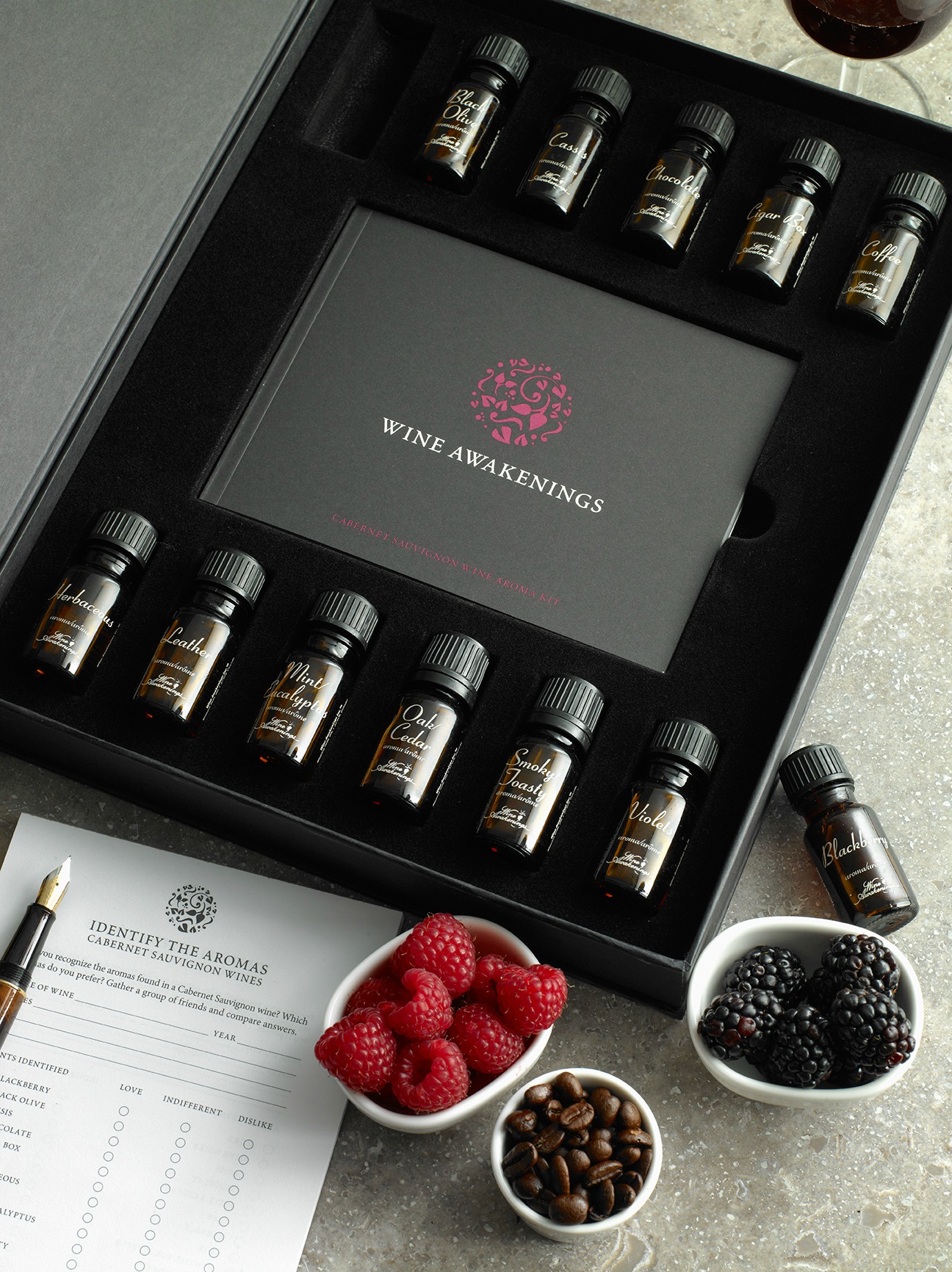
Many tasting wheels have been developed since 1986 and you may have seen some displayed in winery boutiques. Most of them are food and wine pairing wheels, with a view to guide the wine selection for specific foods.
Why am I so passionate about using the Wine Aroma Wheel?
I have used the Wine Aroma Wheel in my teaching and training workshops with wine professionals for many years. I was not the only one! The Wine Aroma Wheel has been used by many renowned wine education programs in North America. To name a few…


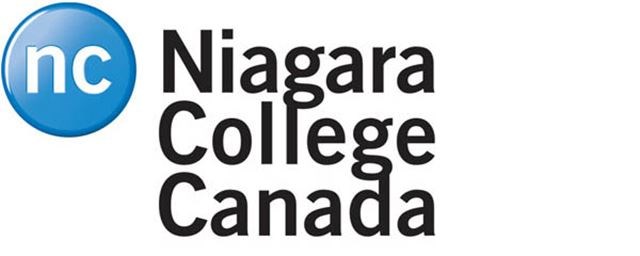

I have found that the 9” wheel enabled the most intimidated taster in the room feel comfortable sharing their sensory experience, starting by using the most general terms on the wheel. This is a very effective tool.
Ann also developed a sparkling wine aroma wheel using the same principles of aroma categorization, including aroma descriptors specific to this wine style.
I had the pleasure to meet Ann in 1996 when she came for a sabbatical leave in Dijon. Our paths have crossed many times when I worked in California and we became friends.
I have partnered with Ann since 2002. I made a French translation of the wheel in 2003, to accompany the other translated wheels made by Ann’s former students or colleagues. We also joined forces and wrote several research articles together.

I hope you will find this wine tasting tool as useful as I do.
Thank you!

